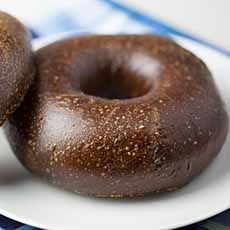ST. PATRICK’S DAY FOOD: An ‘Irish Hoagie’ Recipe
|
Plan ahead to enjoy this delicious sandwich on St. Patrick’s Day. It was created by DiBruno Bros. in Philadelphia, where it’s called the Irish Hoagie. The biggest challenge is finding a pumpernickel baguette in our area. We did find pumpernickel rolls. If you can’t find anything similar, a pumpernickel bagel (cultural fusion!) or a loaf of sliced pumpernickel bread will do. (We’re using the bagel. One of our colleagues couldn’t find a recipe for pumpernickel baguettes, so she’s baking this pumpernickel loaf recipe and cutting it horizontally to emulate a hoagie roll.) Ingredients *Have fun with this Bacon, Lettuce & Tomato Slaw. To Drink 1. SLICE the bread as desired. Layer the mustard, corned beef, and cabbage slaw. Pumpernickel is a type of rye bread that originated in Germany, possibly in the Westphalia region, where a print reference dates to 1450. Westphalian pumpernickel uses coarse rye meal and a very long baking period to give the bread its characteristic dark color. It is traditionally made with an acidic sourdough starter. It is a typically heavy, slightly sweet rye bread traditionally made with sourdough starter and coarsely ground rye. Today, it is often made with a combination of rye flour and whole rye grains. Traditional German pumpernickel contains no coloring agents, instead relying on the Maillard reaction to produce its characteristic deep brown color, sweet, dark chocolate, coffee flavor, and earthy aroma. To achieve this, loaves are baked in long, narrow, lidded pans for 16 to 24 hours in a low-temperature steam-filled oven (120°C or 250°F). Like the French pain de mie, Westphalian pumpernickel has little or no crust. At one time pumpernickel was traditional peasant fare as were all brown breads. Until the Industrial Revolution, the brown endosperm and germ of grain had to be removed laboriously by hand, in order to get white flour. As a result, white flour goods were very expensive. With the German immigration in the late 19th century, various forms of pumpernickel became popular in delicatessens and other food markets. There is often confusion about dark rye bread, which is made from the ground endosperm of the rye berry (the outer endosperm. |
|
|
|
Pumpern was a New High German word for being flatulent. Nickel was a form of the name Nicholas, commonly associated with a goblin or devil (e.g. Old Nick, a familiar name for Satan). Hence, pumpernickel means “devil’s fart.” Why? The loaf was not easily digested, leading to flatulence. Some shops and boutique bakeries in America still use the old recipes. If you can find them, you’re lucky! Otherwise, for a true pumpernickel experience, search out boutique bakeries on your next trip to Germany. |
||




